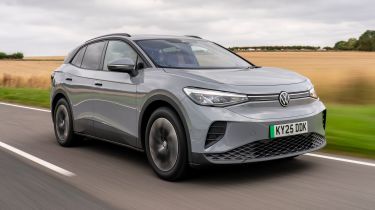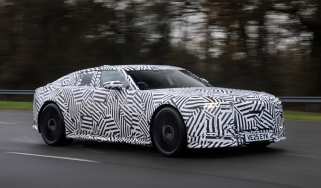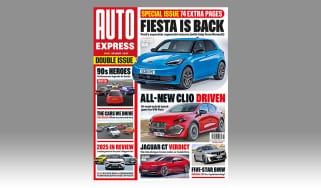Volkswagen ID.4 review
We think the Volkswagen ID.4 appeals to EV buyers after practicality and decent range, but it’s no class leader

Our opinion of the Volkswagen ID.4
The Volkswagen ID.4 won’t set pulses racing, but that’s not really the point of the German brand’s family-sized all-electric SUV. The second ID-badged model follows in the footsteps of the more compact ID.3 hatchback, offering more usable space and good levels of on-board tech, while a comfortable ride and practical range make it a car that’s easy to live with.
The ID.4 isn’t without fault, though. It’s not the most engaging drive, and if you take a look inside, you’ll notice some of the trim is a little cheaper-looking than you might expect compared with its closest rivals. The touch-sensitive controls can be frustrating to use, especially when you're on the move. Overall, the Volkswagen ID.4 is a good, but not class-leading, electric family car.
About the Volkswagen ID.4
The Volkswagen ID.3 hatchback was the first model to ride on the VW Group’s MEB platform, and this ID.4 is its bigger mid-size SUV brother. The versatile EV-specific architecture also serves as the underpinnings for the Volkswagen ID.5 coupe-SUV, Volkswagen ID.7 estate and Volkswagen ID. Buzz minibus, as well as the Audi Q4 e-tron, Cupra Born, Skoda Enyaq and others. Even the Ford Explorer and Ford Capri are MEB cars thanks to a platform sharing deal.
The regular ID.4 comes with either a 52kWh or 77kWh usable battery capacity. The smaller battery cars are dubbed Pure, and those with the bigger battery are called Pro. Most versions have a single motor driving the rear wheels, but there are 4Motion models with all-wheel drive and two motors. The quickest GTX Edition is four-wheel drive only and features a slightly bigger 79kWh battery.
Used - available now
We’ve tested the ID.4 extensively, both individually and against its key rivals, on UK roads. In separate head-to-head tests, different versions have finished second in a triple test against Hyundai Ioniq 5 and Toyota BZ4X, narrowly lost out to the Kia EV6 and finished third against the Ioniq 5 and Ford Mustang Mach-E.
Volkswagen ID.4 prices and latest deals
The Pure and Pro battery options complicate the ID.4 range somewhat. Pure Essential and Pro Essential models open proceedings at just under £37,000 and are eligible for a £1,500 Electric Car Grant (ECG). It means there’s very little point in choosing the smaller ‘Pure’ battery these days, because the larger capacity battery is the same price. The slightly more expensive Pure Match trim also qualifies for the ECG discount.
The rest of the ID.4 range is too expensive to qualify for the £1,500 discount. Pro Match trim offers extra equipment and a larger-capacity battery, as well as the option of 4Motion all-wheel drive with the larger battery. The Pro Black Edition offers the same options but features dark wheels and other styling elements. Finally, the sporty GTX Edition is at the top of the range and costs over £52,000.
You can spec your ideal ID.4 now on the Auto Express Buy A Car service and choose the best offer from dealers around the UK. There are used cars and leasing deals, too, while we can even help you sell your old car.
Electric motor, drive and performance
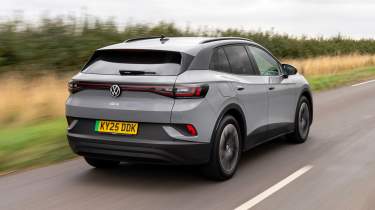
| Pros |
|
| Cons |
|
Volkswagen has tailored the ID.4’s driving experience to differ from similar electric cars. Torque is limited to help deliver smoother progress, and while this impacts the car’s sprinting ability compared to livelier Tesla Model Y or Volvo EX40 rivals, we think this suits the car’s family load-lugging bias better.
We’ve tested the ID.4 extensively head-to-head with its rivals. Piloting the ID.4 will ultimately feel familiar to anyone who has previously driven a mainstream VW model, past or present. Don’t expect too much in the way of driving enjoyment, and you won’t be disappointed.
| Model | Power | 0-62mph | Top speed |
| Pure (52kWh) | 168bhp | 9.0sec | 99mph |
| Pro (77kWh) | 282bhp | 6.7sec | 112mph |
| GTX Edition (77kWh) | 335bhp | 5.4sec | 112mph |
0-62mph acceleration and top speed
The Pure versions of the ID.4 with the smaller 52kWh battery develop 168bhp with 310Nm of torque. On our tests on UK roads, they feel far from underpowered, and 0-62mph in 9.0 seconds is perfectly adequate, particularly to drivers coming from a similar petrol car.
Because the ID.4 models without 4Motion all-wheel drive send power to the rear wheels, there aren’t the issues putting power down on the road you get with front-wheel drive rivals. Even in wet conditions, you won’t experience the wheelspin rivals like the Renault Scenic suffer from.
The Pro models with the 77kWh battery are either rear-wheel drive or all-wheel drive. As standard, there’s 282bhp on tap with a substantial 545Nm of torque for a 0-62mph sprint of 6.7s. Even in light of what we said about VW dialling back the power delivery in the ID.4 for smoother progress, these models feel very fast for a family SUV.
Choosing a 4Motion four-wheel drive model shaves 0.1s off that 0-62mph time thanks to the extra traction. The top speed for all 77kWh cars is 112mph, 13mph more than the ones with the 52kWh battery.
Finally, the GTX Edition is the most performance-focused model in the ID.4 range. It comes standard with 335bhp and 679Nm of torque and four-wheel drive. The 0-62mph time of 5.4s is rapid, although there are quicker mid-size electric SUVs, like the hotter versions of the Tesla Model Y.
Steering, handling and brakes
The ID.4’s steering is slow and light. This contributes to an easy-going feel in normal driving that many buyers will appreciate, but there are plenty of alternatives that perform better than the Volkswagen on faster or twisty roads where drivers want sharper responses.
Switching to the Sport drive mode helps add some directness and reassuring weight to the steering, but the suspension remains on the soft side, contributing to a noticeable amount of body lean in the bends. The ID.4 is a car that is better driven in a relaxed manner. We even found the sporty GTX model underwhelming from a driving engagement perspective; other than the straight-line speed, it feels hardly any more dynamic than the lesser ID.4 models.
We wish there were more settings for the regenerative braking. There are only two modes, and neither is strong enough to allow the one-pedal driving that can be so helpful in stop-start traffic - improving efficiency and meaning that you rarely have to use the brake. The Nissan Ariya, Renault Scenic and others offer full one-pedal driving modes.
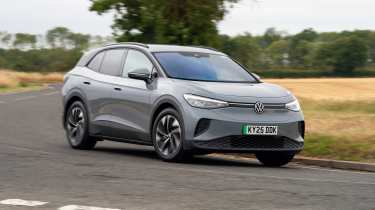
Comfort and refinement
Comfort is much more of an ID.4 strong suit. Lots of EVs have quite busy low speed rides and jiggle across rough surfaces, but this Volkswagen smoothes things out very well. It doesn’t crash into bigger potholes or severe speed bumps, and we found the ID.4 has a better low-speed ride than the Ford Mustang Mach-E and the Hyundai Ioniq 5 during our head-to-head testing.
On longer motorway trips, things are just as smooth, and we have no complaints about refinement, either. There’s every excuse to utilise the adaptive cruise control and let the ID.4 glide on to your destination in complete comfort.
Visibility and parking
The view out of the ID.4 is pretty good, with no serious impediments to seeing what’s happening around the car. A rear camera is standard on all models, and there’s a sound to help warn pedestrians that the ID.4 is in motion.
The Match trim adds Park Assistance Plus with front and rear parking sensors that give an audio warning about the proximity of obstacles. We felt they were a little over zealous, often suggesting an impact was imminent when there was actually room to spare - better to be safe than sorry, though.
Opting for a rear-wheel drive version allows for a tighter turning circle than the four-wheel drive 4MOTION models because there’s no electric motor sandwiched between the front wheels to reduce the amount of steering lock available. It’s another reason why we think the cheaper rear-wheel drive cars make the most sense.
“There’s a lot of adjustment in the driving position and loads of headroom that taller drivers will appreciate. VW’s annoying steering-wheel buttons are still too easy to press accidentally while driving, however.” - Steve Walker, head of digital content
Range, charging and running costs
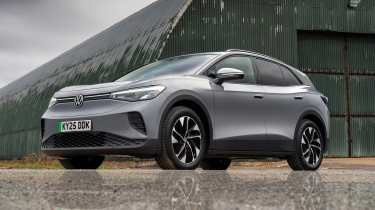
| Pros |
|
| Cons |
|
The ID.4’s base Pure battery provides enough juice for a range of up to 224 miles. If you want to go further between charging sessions, the Pro has the ID.4’s best range figures in rear-wheel drive form. It covers up to 351 miles on a single charge.
The all-wheel drive, dual-motor 4Motion versions come with a 77kWh powerpack, but the range is reduced to 325 miles. The reduction is due to the additional weight and inefficiencies of four-wheel drive compared to the regular rear-wheel drive models. The high-performance GTX Edition models have a range of 321 miles despite having the largest capacity 79kWh battery.
During a test in average UK temperatures, the 77kWh VW ID.4 managed to return around 3.4 miles per kilowatt-hour, equating to a real-world range of 262 miles. We saw similar results when we put an ID.4 GTX against the Toyota bZ4X and Hyundai Ioniq 5 in warmer summer weather. The first time we drove the ID.4 GTX, it was in colder conditions, and it returned 2.7mi/kWh, demonstrating the effects of cold weather on the EV's range.
An interesting and slightly worrying quirk we noted during our testing of the ID.4 in the summer was that switching on the air-con reduced the range by 27 miles.
The ID.4’s maximum charging speed depends on which version you get. Stick with the 52kWh battery, and it will reach 145kW if you find a suitably fast rapid charger. That means a 10 to 80 per cent top-up will take 25 minutes. If you upgrade to the 77kWh battery, the maximum charging speed jumps to 175kW, so the same 10 to 80 top-up of the larger battery requires 28 minutes. The larger capacity 79kWh battery has a higher 185kW peak charging speed, so the same 10 to 80 per cent top up takes 26 minutes.
It’s worth noting that rivals like the Hyundai Ioniq 5 or Kia EV6 car reach a peak speed of 233kW and can be topped up even faster, but you need to have a charger that can deliver those kinds of speeds.
When it comes to charging at home, fully replenishing a 52kWh model will take roughly eight and a half hours, while 77kWh versions will need more than 12 hours plugged into a 7.4kW home wallbox. The 79kWh pack takes the longest to be fully recharged, at around 13 hours.
| Model | Battery size | Range | Insurance group |
| Pure | 52kWh | 222-224 miles | 18-23 |
| Pro | 77kWh | 321-351 miles | 22-39 |
Tax
Driving a battery-powered car brings a lower tax burden. Business users choosing the ID.4 will benefit from the low Benefit-in-Kind tax rate of 3 per cent for 2025/2026, not to mention the cheapest rate of road tax (VED). Some models also dip under the £40,000 bar to avoid the luxury car tax.
Insurance
The entry-level ID.4 models with the Pure powertrain should be reasonably affordable to insure, because they fall within groups 18 and 23. In comparison, the Renault Scenic starts in group 33, partly because it does not offer a smaller battery option.
Opting for the Pro powertrain will get you insurance groups in the 22 to 32 range, depending on trim. The most potent ID.4 GTX is in insurance group 39, but that’s still below the entry-level Tesla Model Y RWD in group 47.
Check if your car needs an MoT and view its complete history with our MoT History Checker...
Depreciation
Our expert data suggests that over a typical three-year/36,000-mile ownership period, the Pro Essential model will retain the most resale value, at 52 per cent, while Pro Black Edition 4MOTION retains the least at 41 per cent.
A Renault Scenic holds onto between 55 and 56% of its value, and a Tesla Model Y is between 46 and 50 per cent, so the Volkswagen is giving quite a bit away to rivals.
To get an accurate valuation for a specific Volkswagen ID.4, check out our free car valuation tool...
Interior, design and technology
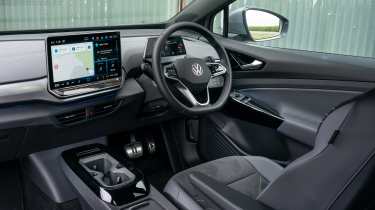
| Pros |
|
| Cons |
|
From the outside, the ID.4 looks smart enough, with its sleek, stylish lines helping to create a premium air. It’s not the most exciting shape on the road, but VW’s electric car design themes are in place.
The ID.4 range is complicated by the Pure and Pro powertrain options having slightly different levels of equipment. All the base Essential trim models come with the following:
- 18” steel wheels
- LED headlights
- Discover Pro infotainment
- Heated front seats
- Keyless entry and start
- Ambient interior lighting
- Rear view camera
- Dual-zone air-conditioning
Match versions have a little extra kit, including 19” alloy wheels, while the Black Edition cars have black styling elements and some upmarket equipment, including a panoramic glass roof and massaging front seats. The GTX Edition is fully loaded, featuring a head-up display and a raft of extra driver assistance features.
Interior and dashboard design
It’s a shame that this quality feel from the exterior isn’t quite carried over into the ID.4’s cabin. The ID.4 has a simple, clean design, but there’s little of the flair that rival models like the Renault Scenic and Peugeot E-3008 manage to include.
One of the irritations we have with the ID.4's cabin surround its steering wheel touch sensitive controls, which are awkward to use and too easy to press by accident when you’re turning the wheel. It’s even possible to engage the cruise control accidentally.
Materials and build quality
Look closely and you’ll notice that the material quality is no better than average. There’s a lot of piano black plastic and only a few splashes of aluminium to lift the rather drab tone. Build quality seems strong enough, but it feels to us like VW needs to do better to regain its reputation for classy car interiors.
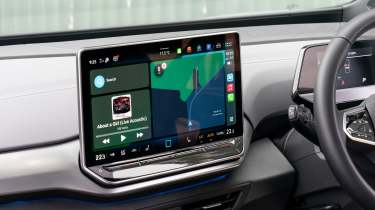
Infotainment, stereo and connectivity
The large 12.9-inch central touchscreen now standard on all ID.4 models, and it controls virtually everything in the cabin. This also includes many of the climate control settings, which is a frustrating design decision in our opinion. There are touch-sensitive slider switches for the temperature and fan under the screen, but these don’t always do what you want them to.
The infotainment system itself is far slicker than the one the ID.4 featured at launch. Clearer menus and shortcut buttons have improved the user experience, but it’s still not one of our favourite setups. Skoda utilises similar Volkswagen Group software, but supports it with additional physical buttons and dials for making quick adjustments on the move.
Loading times for the infotainment system are quick, though - particularly with route mapping. We also like the small 5.3-inch digital instrument display, which is fitted to the steering column and adjusts with the steering wheel so it’s always visible. Wireless Apple CarPlay and Android Auto are convenient and useful features that work better than the built-in software - as is the case with most new cars today.
“The problem for the German firm is that many rival models in this space now match VW for materials and build quality while offering more interesting designs.” - Steve Walker, head of digital content
Practicality, comfort and boot space
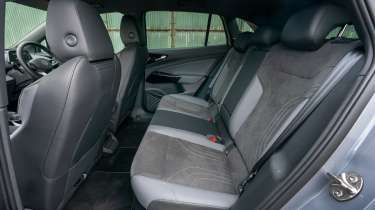
| Pros |
|
| Cons |
|
Family life with the ID.4 should be pretty straightforward because it offers superb practicality. In addition to the spacious interior, there are lots of storage areas and cubbies, with the central bin also providing a wireless charging pad for your smartphone.
Other handy standard features include a rear centre armrest with two cupholders, rain-sensing wipers, a rear-view camera and a keyless go function.
Opting for a rear-wheel drive version allows for a tight turning circle compared to the four-wheel drive Match Pro 4MOTION or GTX models because the former doesn’t have an electric motor sandwiched between the front wheels to reduce the amount of steering lock you can use.
Dimensions and size
The ID.4 measures 4,584mm in length, making it shorter than the Hyundai Ioniq 5 (4,635mm) but longer than the Renault Scenic and Ford Explorer. It’s a little narrower than most of its direct rivals, however, which might help make the ID.4 a little easier to pilot around town and park in tight spaces.
| Model | VW ID.4 | Renault Scenic | Ford Explorer |
| Length | 4,584mm | 4,470mm | 4,468mm |
| Width | 1,852mm | 1,864mm | 1,871mm |
| Height | 1,640mm | 1,571mm | 1,630mm |
|
Wheel- base | 2,771mm | 2,780mm | 2,770mm |
| Boot space | 543 litres | 545 litres | 470 litres |
Seats and passenger space
The driver and front passenger have plenty of space, with decent head and legroom. Rear-seat passengers will have no problem getting comfortable, and the flat floor allows three adult occupants to sit across the rear bench with little complaint.
Parents will be pleased to know that in addition to two Isofix points on the outer positions of the second row, the ID.4 also has a child seat mounting point on the front passenger seat, giving greater flexibility in where you can put your children. Check that the passenger airbag is disabled when using a rear-facing child seat position, though.
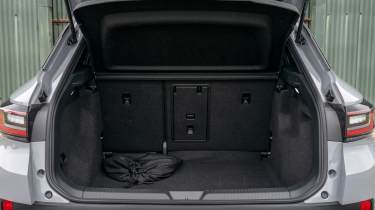
Boot space
Practicality is a real strength of the ID.4. Its useful 543-litre boot capacity betters that of the Ford Explorer, which only has 470-litres, and the Hyundai Ioniq 5, which has 527 litres. Folding the ID.4’s rear seats unlocks a vast 1,575 litres of space, but the seats don’t fold completely flat, leaving an incline to overcome when loading longer items.
Loading larger items is made easier by the relatively low boot lip and the square space inside. The Renault Scenic has slightly larger boot space overall, but the ID.4’s is a lot more uniform and useful in shape when it comes to packing
Towing
All ID.4 models have a maximum braked trailer load limit of 1,000kg, with the exception of the four-wheel drive 4Motion cars, which can tow 1,200kg, and the GTX Edition, which can tow 1,800kg. More electric cars can tow decent amounts these days, so the 1,000kg limit for the base cars is a little disappointing. Always double-check load limits for your car before attempting any towing.
Reliability and safety
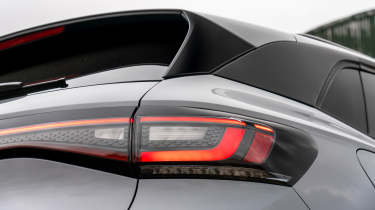
| Pros |
|
| Cons |
|
The ID.4’s MEB platform is used by nearly a dozen electric cars across the VW Group, which bodes well for overall reliability.
Overall safety is worth highlighting because the ID.4 not only achieved a full five-star rating when crash tested by Euro NCAP, in 2021 but also gained Advanced status, a mark of a car’s superior on-board safety technology.
Volkswagen’s all-electric family SUV gained a 93 per cent score for adult protection, 89 per cent for child occupants and 85 per cent for the car’s safety systems, all of which were higher than those of the Ford Mustang Mach-E that was tested under the same regime.
Standard safety kit for all ID.4 versions includes adaptive cruise control, autonomous emergency braking with cyclist and pedestrian detection, a driver fatigue alert system, Dynamic road sign display and a Lane Assist function.
Although it didn't appear in our most recent Driver Power owner satisfaction survey, the Volkswagen brand finished in a disappointing 27th position out of 32 manufacturers in the best brands poll in 2025.
| Euro NCAP safety ratings |
|
Buying and owning
Our best buy: Volkswagen ID.4 Pro Essential
We think you have to buy the 77kWh Pro battery in the ID.4. The range is 100-miles better than the 52kWh version, and now the prices for the entry-level car have come down so much, there’s no reason to buy the smaller Pure battery.
The 4Motion models at the top of the range won’t be worth the extra outlay for most buyers, while the standard rear-wheel drive models offer better efficiency and manoeuvrability. They’re predicted to hold their value a bit better, too. If you really need to tow or must have the extra performance, the GTX Edition could be worth considering, but our best buy is the Pro Essential model.
Volkswagen ID.4 Alternatives
Being an electric mid-size family SUV, the ID.4 has plenty of rivals. It competes with the accomplished Skoda Enyaq and Audi Q4, which use the same VW Group platform, as well as the Ford Explorer, which employs the same technology.
The talented Korean duo of the Hyundai Ioniq 5 and Kia EV6 are always in the frame, while the Nissan Ariya (our 2022 Car of the Year), Renault Scenic and Peugeot E-3008 are also appealing options. The Tesla Model Y remains very popular with its unique technology and Tesla’s charging network to recommend it.
Deals on the Volkswagen ID.4 and alternatives
Frequently Asked Questions
Volkswagen offers a standard three-year warranty, although it does provide breakdown cover throughout this period for ID models. The battery pack comes with its own eight-year/100,000-mile cover.
